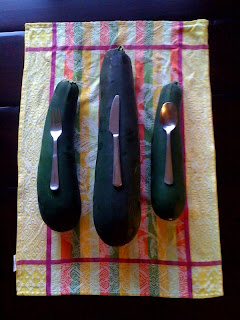Learning to garden and cook has been a real process for me. As a scientist, I expect that there are Best Ways To Do Things that someone before me has already figured out (science couldn't happen if we didn't rely on each other- "standing on the shoulders of giants" and all that). The result is that I scour the internet and have amassed quite a decent library of gardening guides and cookbooks.
Only now, though, do I feel confident enough to break out on my own. I have spent enough time tending the garden to have a fair idea what to expect. Perhaps more importantly, I'm no longer terrified of not knowing that
one little thing that will send the whole garden into a spiral of disaster. Chances are, that
one little thing doesn't exist, and if it does, no amount of reading or studying or worrying is going to prepare me for it.
The same goes in the kitchen. My husband will be the first to tell you that I used to
never veer from a published recipe. If it called for 1/8 teaspoon of cumin, you bet your @ss I was measuring out the 1/8 tsp precisely. The same went for things like salt and pepper measurements. My husband thought I was nuts. I have three explanations for this behavior:
1. I was once a geochemist (for 2.5 years) and chemists
do not adjust their measurements willy-nilly. Ever.
2. I learned to bake before I learned to cook. An eighth tsp of cornstarch means an eighth tsp of cornstarch.
3. I had no experience and therefore no confidence in branching out on my own. Why mess up a perfectly good meal by not following the recipe. Do I know better than these masters of culinary artistry who wrote this recipe? I think not.
Well, I am happy to report that I now have enough experience and confidence to throw things around in the kitchen. I can't imagine measuring salt or pepper (or most spices for that matter). I read recipes and then forget half the details but try to pull it together anyway. I still use recipes, all the time. It's just in a very different style than before. I use recipes as guidelines or inspiration, not rigid rules which must be followed to the decimal point.
All this back story at last brings me around to the point of today's post (that took a while). I made a delicious meal last week (repeated this weekend) through no more planning than determining what was ripe in the garden and what was kicking around in the fridge. For many people, that's normal. For me, it represents a personal breakthrough from my dependence on recipes. I can now cook for and by myself. Yippee!
In the garden I had four little zucchinis just ready to be picked. Alone, they weren't really enough for a meal. I went inside and starting picking through the fridge to see what I could combine them with. I found some flatbread (left over from chicken souvlaki), some basil (left over from pesto), and some Saint Andre cheese (heaven in cheese form- it's similar to Brie but a million times more delicious). This would form the basis of my dinner. I served it alongside some leftover pesto pasta and was so happy when I finished dinner I didn't want to drink any water for fear of washing away the lovely flavors.
Zucchini Basil Flatbread
serves 1, easily up-scaled or served as an appetizer
4 baby zucchini or 1 medium zucchini, diced (~1 cup)
Olive oil
Red pepper flakes
Salt and pepper
1 round flatbread (I use Trader Joe's; pita would work well, too)
1 bunch basil
~half a wedge St. Andre cheese (if using Brie, may need less)
1. Put a splash of
olive oil in a small pan over medium heat. Add
red pepper flakes to the oil. When the oil is hot, add diced zucchini. Cover and saute, about 5-10 minutes. When zucchini are cooked through, remove lid and add
salt and
pepper. Continue to saute, about 5 minutes, until some zucchini are brown in spots. Remove from heat.
2. Toast
flatbread. Slice
cheese thinly and layer over toasted flatbread (the heat from the bread will melt the cheese slightly). Cover cheese with a layer of
basil leaves. Top basil with sauteed zucchini. Add a dash of kosher salt. Enjoy!
p.s. the orange in the photo above is the zucchini blossom- I sliced it up and tossed it in at the end of the zucchini sauteing cause, why not?


